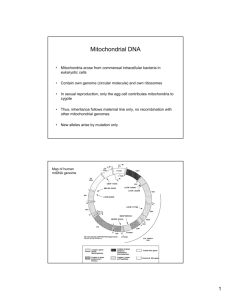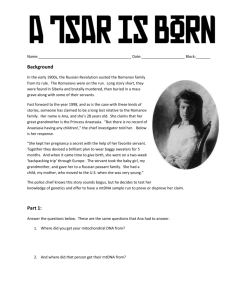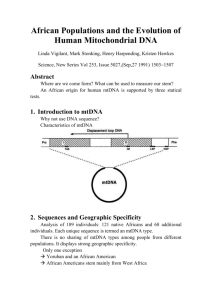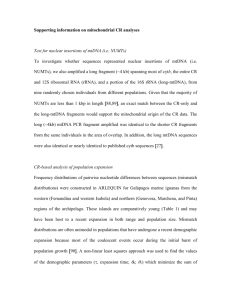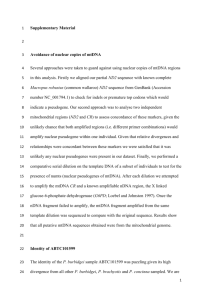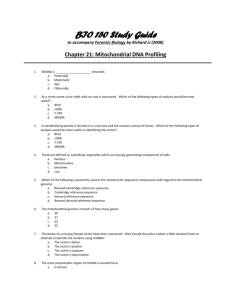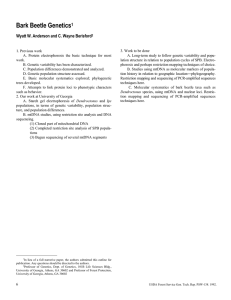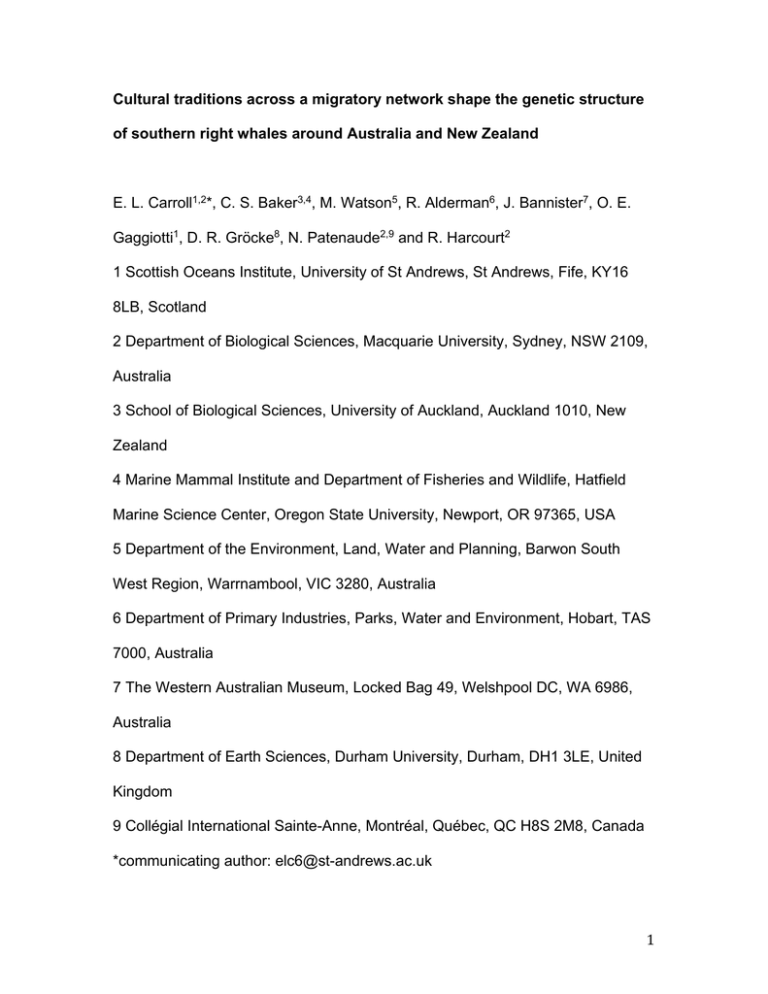
Cultural traditions across a migratory network shape the genetic structure
of southern right whales around Australia and New Zealand
E. L. Carroll1,2*, C. S. Baker3,4, M. Watson5, R. Alderman6, J. Bannister7, O. E.
Gaggiotti1, D. R. Gröcke8, N. Patenaude2,9 and R. Harcourt2
1 Scottish Oceans Institute, University of St Andrews, St Andrews, Fife, KY16
8LB, Scotland
2 Department of Biological Sciences, Macquarie University, Sydney, NSW 2109,
Australia
3 School of Biological Sciences, University of Auckland, Auckland 1010, New
Zealand
4 Marine Mammal Institute and Department of Fisheries and Wildlife, Hatfield
Marine Science Center, Oregon State University, Newport, OR 97365, USA
5 Department of the Environment, Land, Water and Planning, Barwon South
West Region, Warrnambool, VIC 3280, Australia
6 Department of Primary Industries, Parks, Water and Environment, Hobart, TAS
7000, Australia
7 The Western Australian Museum, Locked Bag 49, Welshpool DC, WA 6986,
Australia
8 Department of Earth Sciences, Durham University, Durham, DH1 3LE, United
Kingdom
9 Collégial International Sainte-Anne, Montréal, Québec, QC H8S 2M8, Canada
*communicating author: elc6@st-andrews.ac.uk
1
Supplementary Material 1: Construction of DNA and stable isotope profiles
DNA extraction, sex identification and mtDNA haplotype sequencing
Total genomic DNA was extracted from skin biopsy samples using standard
proteinase K digestion and phenol/chloroform methods1 as modified by Baker et
al.2 for small tissue samples.
The sex of sampled whales was identified by amplification of a portion of the sexdetermining region on the Y chromosome, multiplexed with an amplification of
the ZFY/ZFX region as positive control3,4.
For Australia, we used mtDNA sequences from Carroll et al.5 and used the
methods in this paper to generated new mitochondrial DNA control region
(mtDNA) haplotypes from the samples not previously analysed. For these new
sequences, we aligned and edited mtDNA sequences in either Sequencher
v4.2TM (Gene Codes Corporation) or Geneious v76. Haplotypes were identified
from a 500 bp consensus region and identified following the naming convention
of Carroll et al.5. For New Zealand, we used 692 mtDNA haplotypes associated
with unique DNA profiles generated in Carroll et al7.
Microsatellite genotyping
Seventeen microsatellite loci were amplified in individual 10 μL PCR reactions
under conditions and reaction mixtures described in Supplementary Table 2.
2
Amplicons from 4-6 loci were co-loaded for electrophoresis using an ABI3730 or
an ABI3130. As a precaution against poor DNA quality, samples had to
genotyped at a minimum of 10 loci to be included in subsequent analyses.
Matching genotypes identified by CERVUS v3.0 were assumed to be replicate
samples from the same individual and the average probability of identity (PID7)
was calculated from these matching genotypes. When a replicate was identified,
only one copy of the genotype was retained per sampling location for subsequent
analyses.
Each 96-well tray included a set of 4-7 internal controls to ensure consistent
allele sizing and a negative control to detect contamination. GENEPOP v4.09
was used to test for linkage disequilibrium and CERVUS v3.0 was used to test
for deviations from the Hardy-Weinberg equilibrium.
Stable isotope analysis
A subsample of the skin biopsy sample was freeze dried and underwent lipid
extraction following Todd et al10. Total carbon, total nitrogen content and stable
isotope analysis of the approximately 500 micrograms of each sample were
performed using a Costech Elemental Analyser (ECS 4010) connected to a
ThermoFinnigan Delta V Advantage isotope ratio mass spectrometer. Carbon
isotope ratios were corrected for 17O contribution and reported in standard delta
(δ) notation in per mil (‰) relative to Vienna Pee Dee Belemnite (VPDB). Isotopic
accuracy was monitored through routine analyses of in-house standards for each
3
run, which were stringently calibrated against international standards (e.g.,
USGS 40, USGS 24, IAEA 600, IAEA N1, IAEA N2): this provided a linear range
in δ13C between –46.7 ‰ and +2.9 ‰ and in δ15N between –4.5 ‰ and +20.4
‰. All isotopic results are corrected against this linear range of standards.
Analytical uncertainty in carbon isotope analysis was typically ±0.1 ‰
for replicate analyses of the international standards and typically <0.2 ‰
on replicate sample analysis. Analytical uncertainty in nitrogen isotope analysis
was typically ±0.1 ‰ for replicate analyses of the international standards
and typically <0.2 ‰ on replicate sample analysis. Total carbon and nitrogen
data was obtained as part of the isotopic analysis using an internal standard
(Glutamic Acid, 40.82 % C, 9.52 % N). CN ratios are expressed atomically.
Isotope ratios are expressed as δ13C or δ 15N (‰) = [(Rsample/Rstandard)-1] x 1000,
where R is 13C/12C or 15N/14N, for δ13C or δ15N, respectively.
Supplementary Material 2: Results from comparison of genetic data and
δ15N values
An interaction was indicated by plotting the mean of δ15N against two-way
combinations of factors, so we considered GLMs with interaction terms.
4
For the δ15N data, there were four models closely ranked using ∆AIC
(Supplementary Table 4). The best model indicated by residual deviance was
also mtDNA*sex*state. However, models considering sex and state only, ranked
highly using ∆AIC, whereas the model that only considered mtDNA was ranked
last, indicating it was a weaker explanatory factor in the δ15N dataset. Visual
inspection of the residuals of the mtDNA*sex*state models for both datasets
indicated the data were normally distributed.
The randomisation test of Valenzuela et al.11 indicated no relationship between
δ15N isotopic similarity and matriline (p>0.05). In addition, there was no significant
relationship between the relatedness estimates of Ritland12 (p>0.05) and Lynch
and Ritland13 (p>0.05) and the Euclidean distances of δ15N based on the results
of the mantel tests.
5
Supplementary Table 1: Details of samples used in the analysis, including sex,
sampling location (State; New South Wales: NSW, Queensland: QLD, South
Australia: SA, Victoria: VIC and Western Australia: WA), mitochondrial control
region haplotype (mtDNA), and the habitat classification of the sampling area as
a migratory (MIG) or calving ground (CAL).
Sample
Eau08EA01
Eau10EA03
Eau10EA04
Eau10EA05
Eau10EA06
SRWEA0305
SRWEA0306
MQ38
MQ13
MQ39
MQ37
MQ27
Eau0102
Eau0103
Eau0104
Eau0105
Eau0107
Eau0108
Eau0109
Eau0110
Eau0111
Eau0112
Eau0116
Eau0117
Eau0118
Eau0201
Eau0202
Eau0203
Eau0204
Eau0206
Eau0207
SRWEA0301
Sex
F
M
M
F
F
F
F
F
M
F
F
F
F
M
M
F
F
M
M
M
M
F
M
M
F
F
F
F
F
M
M
F
Location
Sydney
Narooma
Narooma
Narooma
Narooma
Newcastle
Merimbula
Jervis Bay
Narooma
Jervis Bay
?
Sunshine Coast
Encounter Bay
Encounter Bay
Encounter Bay
Cape Jervis
Encounter Bay
Encounter Bay
Encounter Bay
Encounter Bay
Encounter Bay
Encounter Bay
Encounter Bay
Encounter Bay
Encounter Bay
Encounter Bay
Encounter Bay
Encounter Bay
Encounter Bay
Encounter Bay
Encounter Bay
Encounter Bay
State
NSW
NSW
NSW
NSW
NSW
NSW
NSW
NSW
NSW
NSW
NSW
QLD
SA
SA
SA
SA
SA
SA
SA
SA
SA
SA
SA
SA
SA
SA
SA
SA
SA
SA
SA
SA
mtDNA
BakHapB+
BakHapA
BakHapE
BakHapC
BakHapA
BakHapB+
PatHap17
BakHapC
BakHapA
BakHapA
BakHapA
BakHapB+
BakHapA
BakHapC
BakHapA
BakHapC
BakHapA
BakHapC
BakHapA
BakHapA
BakHapC
BakHapE
BakHapA
BakHapA
BakHapA
BakHapD
BakHapD
BakHapE
SWPJ
BakHapC
BakHapC
BakHapB+
Hab
MIG
MIG
MIG
MIG
MIG
MIG
MIG
MIG
MIG
MIG
MIG
MIG
MIG
MIG
MIG
MIG
MIG
MIG
MIG
MIG
MIG
MIG
MIG
MIG
MIG
MIG
MIG
MIG
MIG
MIG
MIG
MIG
6
Sample
SRWEA0302
SRWEA0303
Eau07Tas01
Eau07Tas02
Eau07Tas03
Eau12Tas01
Eau12Tas02
Eau12Tas03
Eau12Tas04
Eau12Tas05
Eau12Tas06
Eau12Tas07
Eau0113
Eau0115
Eau0208
Eau0209
Eau0210
Eau09EA01
Eau09EA02
SRWEA0304
SRWEA0401
SRWEA0402
MQ29
MQ32
MQ35
MQ33
MQ36
MQ34
WARW9502
WARW9503
WARW9511
WARW9512
Eau94WA01
WARW9507
WARW9508
WARW9509
WARW9510
WARW9516
Eau94WA02
Eau94WA03
Eau94WA05
WARW9505
Sex
F
M
M
F
M
M
M
F
M
F
M
F
F
F
F
M
F
F
F
F
F
F
M
M
F
F
F
M
F
M
M
M
N/A
F
F
M
M
M
M
M
N/A
M
Location
Encounter Bay
Encounter Bay
Goats Beach, Storm Bay
Goats Beach, Storm Bay
Goats Beach, Storm Bay
Dodges Ferry
Seven Mile Beach
Cremorne
Adventure Bay
Adventure Bay
Adventure Bay
Adventure Bay
Warrnambool
Warrnambool
Warrnambool
Warrnambool
Warrnambool
Warrnambool
Warrnambool
Warrnambool
Warrnambool
Warrnambool
Warrnambool
Port Fairy
Port Fairy
Port Fairy
Warrnambool
Port Fairy
Bremer/Doubtful Is. Bay
Bremer/Doubtful Is. Bay
Bremer/Doubtful Is. Bay
Bremer/Doubtful Is. Bay
Bremer/Doubtful Is. Bay
Bremer/Doubtful Is. Bay
Bremer/Doubtful Is. Bay
Bremer/Doubtful Is. Bay
Bremer/Doubtful Is. Bay
Bremer/Doubtful Is. Bay
Bremer/Doubtful Is. Bay
Bremer/Doubtful Is. Bay
Bremer/Doubtful Is. Bay
Bremer/Doubtful Is. Bay
State
SA
SA
TAS
TAS
TAS
TAS
TAS
TAS
TAS
TAS
TAS
TAS
VIC
VIC
VIC
VIC
VIC
VIC
VIC
VIC
VIC
VIC
VIC
VIC
VIC
VIC
VIC
VIC
WA
WA
WA
WA
WA
WA
WA
WA
WA
WA
WA
WA
WA
WA
mtDNA
BakHapB+
BakHapC
CarHapJ
PatHap4
BakHapA
BakHapE
BakHapA
BakHapB+
BakHapA
BakHapA
BakHapA
BakHapC
BakHapA
BakHapB+
BakHapD
BakHapB+
BakHapE
BakHapB+
BakHapB+
BakHapD
BakHapA
BakHapD
BakHapC
BakHapE
PatHap17
BakHapA
BakHapA
BakHapC
BakHapA
BakHapC
BakHapA
BakHapC
SWPJ
BakHapA
BakHapC
BakHapE
BakHapC
BakHapE
BakHapA
BakHapA
N/A
BakHapF
Hab
MIG
MIG
MIG
MIG
MIG
MIG
MIG
MIG
MIG
MIG
MIG
MIG
CAL
CAL
CAL
CAL
CAL
CAL
CAL
CAL
CAL
CAL
CAL
MIG
MIG
MIG
CAL
MIG
CAL
CAL
CAL
CAL
CAL
CAL
CAL
CAL
CAL
CAL
CAL
CAL
CAL
CAL
7
Sample
WARW9514
WARW9515
WARW9517
Sex
F
F
M
Location
Bremer/Doubtful Is. Bay
Bremer/Doubtful Is. Bay
Bremer/Doubtful Is. Bay
State
WA
WA
WA
mtDNA
BakHapA
BakHapA
BakHapA
Hab
CAL
CAL
CAL
8
Supplementary Table 2: Seventeen loci used for microsatellite genotyping of
southern right whales. Details include primer sequences, fluorescent label,
annealing temperature (TA), magnesium concentration (mM Mg) and reference.
Locus
CA232
EV1Pm
EV37Mn
EV14Pm
EV94
GATA028
GATA098
GT23
GT310
RW18
RW31
RW48
RW410
RW26
TR3F4
TR3G1
TR3G2
Primers
F: CACTCAGATTAAGACTTCAGA
R: GATCACATAATCTTGATCAGA
F: CCCTGCTCCCCATTCTC
R: ATAAACTCTAATACACITCCTCCAAC
F: AGCTTGATTTGGAAGTCATGA
R: TAGTAGAGCCGTGATAAAGTGC
F: TAAACATCAAAGCAGACCCC
R: CCAGAGCCAAGGTCAAGAG
F: ATCCTATTGGTCCTTTTCTGC
R: AATAGATAGTGATGATGARCACACC
F: AAAGACTGAGATCTATAGTTA
R: CGCTGATAGATTAGTCTAGG
F: TGTACCCTGGATGGATAGATT
R: ATGTCTCTCTCACACCTCACC
F: GTTCCCAGGCTCTGCACTCTG
R: CATTTCCTACCCACCTGTCAT
F: GAATACTCCCAGTAGTTTCTC
R: TAACTTGTGGAAGATGCCAAC
F: AGAGGGAAGCAAACTGGA
R: GAAGGNTGCCAGACACCC
F: TATTCATGGAGTGCTTTGG
R: CCTAGAGTCCAGTGTGGTA
F: CCAATGACTTTTCCCTGTA
R: GATACCGCAGTGTGTCCTG
F: ATGGCATTACTTCATTCTTT
R: GCCAAACTTACCAAATTGTG
F: GTCCATCCATATTACTGC
R: CAGTTATACCTCAATGAAGC
F: TGCTCTGCAACAAGAGAAGC
R: GCCAAGGTTTTAGAGAGAGTG
F: CTCCGCAACAAGAGAGGC
R: CTTCCTGGGTACAAGCCC
F: CTGCGGTGTTGGTTAATAGC
R: CCTGACATTTTCTGTGTCCC
Label
TA
(ºC)†
mM
Mg
FAM
55
2.5
Bérubé et al.14
NED
60
2.5
Valsecchi & Amos15
NED
54
2.5
Valsecchi & Amos15
VIC
51
2.5
Valsecchi & Amos15
FAM
55
2.0
Valsecchi & Amos15
NED
50
2.5
Palsbøll et al.16
VIC
50
2.5
Palsbøll et al.16
VIC
58
2.0
Bérubé et al.17
NED
59
2.0
Bérubé et al.17
FAM
60
2.5
Waldick et al.18
FAM
54
2.0
Waldick et al.18
NED
50
2.5
Waldick et al.18
VIC
50
2.5
Waldick et al.18
NED
50
2.5
Waldick et al.18
FAM
59
2.0
Frasier et al.19
FAM
*A
2.5
Frasier et al.19
VIC
50
2.5
Frasier et al.19
Reference
9
†These
reactions have cycling conditions of (i) an initial denaturing step at 94 °C
for 3 min; (ii) 35 cycles at 94 °C for 30 sec, TA for 30 sec and 72 °C for 30 sec;
and (iii) a final extension step at 72 °C for 10 min. *A indicates this primer pair had
a touchdown PCR protocol: for the cycling, each annealing temperature is used
for five cycles before stepping down to the next annealing temperature; the final
annealing temperature is used for 10 cycles, resulting in a total of 30 cycles.
Annealing temperatures are 68 °C, 64 °C, 61 °C, 58 °C and 55 °C.
10
Supplementary Table 3: DNA profiles for southern right whales recaptured between days or years on the Australian
wintering grounds. DNA profiles comprise genetically identified sex (Sex), mitochondrial control region haplotype (mtDNA:
haplotype code as described in Carroll et al. 2011b) and multilocus genotype (EV1 – TR3G2). The sampling location
(STATE), probability of identity (PID), number of matching loci (NM), and number of loci each sample is amplified at (Nloci)
are also reported. Missing data at a locus are denoted by 0. Most notable matches are of two females that were sampled
in different years in Warrnambool, Victoria. The first femaleA was captured in 2001 and recaptured in 2009 (as previously
reported in Carroll et al 2011), and the second femaleB was captured in 2004 and subsequently recaptured in 2009. In
addition, another femaleC was sampled in 2007 in two different locations along the NSW coast – Merimbula and Eden.
Sample Year NM/PID mtDNA Eau01EA03 Eau01EA06 Eau02EA04 Eau02EA05 2001 2001 2002 2002 MQ26C Eau07EA01 2007 2007 13/ 1.94E‐17 11/ 1.18E‐16 11/ 11 BakHapC BakHapC SWPJ SWPJ CarHapJ CarHapJ EV1 EV14 sex STATE CA232 136 136 136 144 133 133 SA M 0 0 136 144 133 133 SA M 142 150 122 144 133 141 SA F 0 0 122 144 133 141 SA F 0 0 122 136 120 133 NSW F 0 0 122 136 120 133 NSW F EV37 195 195 203 203 199 199 EV94 GATA28 GATA98
203 200 200 178 178 112 203 0 0 178 178 112 203 196 200 166 166 112 203 0 0 166 166 112 205 0 0 174 178 112 205 0 0 174 178 112 112 112 112 112 116 116 11
Sample Year NM/PID mtDNA Eau10EA02 2010 13/ BakHapB+ F Eau10EA05 2010 7.78E‐20 BakHapB+ F Eau01EA14A 2001 13/ BakHapB+ F Eau09EA02 2009 2.48E‐18 BakHapB+ F Eau04EA01B 2004 9/ BakHapA F MQ28 2009 9.31E‐14 BakHapA
F
MQ31 MQ32 Sample Eau01EA03 Eau01EA06 Eau02EA04 Eau02EA05 MQ26 Eau07EA01 Eau10EA02 Eau10EA05 VIC VIC VIC VIC
2012 2012 11/ 1.04E‐13 BakHapE
BakHapE
M
M
VIC
VIC
GT12 GT310 EV1 136 136 0 0 140 140 0 0 140 140 0 0 0 0 0 0 NSW NSW GT23 CA232 sex STATE 134 134 EV14 EV37 134 122 133 189 199 134 122 133 189 199 142 142 130 130 126 126 148 148 138 138 148 148 133 133 131 131 133 133 141 141 141 141 135 135 193 193 193 193 189 189 EV94 0 0 0 0 GATA28 GATA98 166 166 116 120 166 166 116 120 203 0 0 168 178 203 0 0 168 178 199 196 200 166 170 199 0 0 203 0 0 166 178 203 0 0 166 178 RW18 RW31 RW410 RW48 TR3F4 TR3G1 TR3G2
Nloci 112 120 138 138
0 0 199 199 117 125 122 124 203 203 301 333 238 238 176 184
16 112 120 199 199 117 125 122 124 203 203 301 333 238 238 176 184
13 0 0 0 0 118 120 138 138
0 0 0 0 0 0 0 121 123 108 122 197 205 305 345 214 226 184 188
11 114 116 0 0 0 0 0 0 123 127 118 122 197 205 301 333 206 226
0 11 114 116 0 0 0 0 193 199 123 127 118 122 197 205 301 333 206 226 176 180
13 0 187 193 121 123 108 122 197 205 305 345 214 226 184 188
0 0
98
100 195 225 123
125 118 120 211 211 329 333 210 210 176 176
15 112 116 0 0
0
0 195 225 123
125 118 120 211 211 329 333 210 210 176 176
13 116 116 116 116 116 116 0 112 112 104 104 116 116 16 112 116 0 0 12
Sample GT23 Eau01EA14 Eau09EA02 RW18 RW31 RW410 RW48 TR3F4 TR3G1 TR3G2 0 0 98 114 120 0 0 0 0 112 114 138 138
0 0 0 0 125 125 124 124 209 211 301 305 238 238
112 114 102 187 193 125 125 108 122 197 205 309 317 210 218 172 184
187 193 125 125 108 122 197 205 309 317 210 218 172 184
0 0 14 195 213 125 125 124 124 209 211 301 305 238 242 176 180
12 0 0 120 120 0 0 0 0 0 120 120 0 0 0 0 0 13 0 15 Nloci 0 MQ31 MQ32 GT310 114 120 Eau04EA01 MQ28 GT122 0 121 125 120 124 197 211 301 337 210 238
0 0 11 0 121 125 120 124 197 211 301 337 210 238
0 0 11 13
Supplementary Table 4: Estimated levels of genetic diversity of southern right
whale sampling locations and stocks. The sample size (Nm), number of
mitochondrial DNA (mtDNA) haplotypes (NH), haplotype (h) and nucleotide
diversity (π) are estimated based on 500 bp of the mtDNA control region. The
microsatellite sample size (2N), average number of alleles (k) and observed
(HOBS) and expected heterozygosities (HEXP) are based on 17 microsatellite loci.
mtDNA
Region
Nm
NH
h±SD
NSW
12
6
TAS
10
VIC
microsatellite
π±SD
2N
k
HOBS
HEXP
0.82±0.96 1.41±0.80 24
6.41
0.77
0.77
6
0.78±0.14 1.16±0.68 20
6.11
0.75
0.77
16
6
0.86±0.05 1.99±1.08 32
6.65
0.81
0.79
SA
22
6
0.77±0.06 1.67±0.90 44
7.12
0.70
0.74
WA
16
5
0.71±0.09 1.51±0.83 34
6.47
0.78
0.76
SEA
39
8
0.81±0.04 1.59±0.84 78
8.47
0.77
0.77
SWA
38
7
0.74±0.50 1.58±0.83 78
7.94
0.75
0.76
NZ
692
12
0.76±0.01 1.39±0.07 102
8.65
0.71
0.75
Stocks
14
Supplementary Table 5: Mitochondrial control region haplotype frequencies
across southern right whale calving grounds (New Zealand (NZ), Victoria (VIC)
and Western Australia (WA)) and migratory corridors (New South Wales (NSW),
Tasmania (TAS), Victoria (VIC-M) and South Australia (SA)).
NZ-C
NSW-M
VIC-C
SA
WA
BakHapA
231
5
3
1
5
8
8
BakHapB’
87
0
0
0
0
0
0
BakHapB+
207
2
4
0
1
2
0
BakHapC
58
2
1
1
1
7
4
BakHapD
82
0
3
0
0
2
0
BakHapE
6
1
1
1
1
2
2
BakHapF
0
0
0
0
0
0
1
CarHapJ
1
1
0
0
1
0
0
CarHapK
2
0
0
0
0
0
0
PatHap04.1
1
0
0
0
0
0
0
PatHap04.2
12
0
0
0
1
0
0
PatHap17
1
1
0
1
0
0
0
PatMalHapB
4
0
0
0
0
0
0
SWPJ
0
0
0
0
0
1
1
Total
692
12
12
4
10
22
16
VIC-M TAS
15
Supplementary Table 6: Pairwise comparisons of southern right whale calving
grounds, based on samples collected from New Zealand (NZ), Victoria (VIC) and
Western Australia (WA) and migratory corridors, based on samples collected
from South Australia (SA), Tasmania (TAS) and New South Wales (NSW). A.
mtDNA-based FST (bottom left quadrant) and ΦST (top right quadrant) B.
microsatellite-based FST (bottom left quadrant) and Jost’s D (top right quadrant)
A.
WA
SA
VIC
TAS
NSW
NZ
B.
WA
SA
VIC
TAS
NSW
NZ
WA
0.000
0.098*
0.000
0.000
0.088**
WA
0.005
0.011*
0.018**
0.002
0.016**
SA
0.000
0.032
0.000
0.000
0.055*
SA
0.026
0.000
0.010*
0.007
0.003
VIC
0.057
0.010
0.032
0.002
0.000
VIC
0.038*
0.000
0.004
0.014
0.000**
TAS
0.062
0.082
0.048
0.000
0.029
TAS
0.062**
0.036*
0.015
0.015
0.005
NSW
0.006
0.012
0.004
0.000
NZ
0.164**
0.144**
0.029
0.025
0.005
0.010
NSW
0.003
0.028
0.046
0.054
NZ
0.051**
0.016
0.000**
0.020
0.024
0.006
*p<0.05; **p<0.01
16
Supplementary Table 7: Results of generalised linear modelling of δ13C and δ15N
values. Mitochondrial control region haplotype (mtDNA), sex or sampling region
(state; sampling location from Table 1 and Supplementary Table 3) were fitted as
explanatory variables for δ13C or δ15N profiles of 66 southern right whales
sampled around Australia. Interaction terms are denoted by two factors with “:”
between them. Models are ranked using ∆AIC and model weight is listed.
δ13C model
MTDNA + SEX + STATE + STATE:SEX
MTDNA + SEX + STATE + SEX:MTDNA + STATE:SEX
∆AIC
0.00
2.46
Weight
0.69
0.20
MTDNA + SEX + STATE + STATE:MTDNA + STATE:SEX
MTDNA + STATE
6.27
6.85
0.03
0.02
MTDNA + STATE + STATE:MTDNA
MTDNA + SEX + STATE
SEX + STATE + STATE:SEX
MTDNA + SEX + STATE + STATE:MTDNA
MTDNA + SEX + STATE + SEX:MTDNA + STATE:MTDNA +
STATE:SEX
MTDNA + SEX + STATE + SEX:MTDNA
MTDNA
MTDNA + SEX
SEX + STATE
MTDNA + SEX + STATE + SEX:MTDNA + STATE:MTDNA
MTDNA + SEX + SEX:MTDNA
STATE
SEX
7.71
8.24
8.57
9.16
0.01
0.01
0.01
0.01
9.44
10.44
11.33
12.57
13.75
14.18
14.27
14.89
19.93
0.01
0.00
0.00
0.00
0.00
0.00
0.00
0.00
0.00
∆AIC
0.00
Weight
0.82
5.31
6.66
6.86
8.49
8.57
9.39
10.60
0.06
0.03
0.03
0.01
0.01
0.01
0.00
δ15N model
MTDNA + SEX + STATE + SEX:MTDNA + STATE:MTDNA
MTDNA + SEX + STATE + SEX:MTDNA + STATE:MTDNA +
STATE:SEX
MTDNA + SEX + STATE + STATE:MTDNA + STATE:SEX
STATE
SEX + STATE
SEX
SEX + STATE + STATE:SEX
MTDNA + SEX + STATE + SEX:MTDNA
17
MTDNA + SEX + STATE + SEX:MTDNA + STATE:SEX
MTDNA + SEX + SEX:MTDNA
MTDNA + STATE + STATE:MTDNA
MTDNA + SEX + STATE + STATE:MTDNA
MTDNA
MTDNA + STATE
MTDNA + SEX
MTDNA + SEX + STATE
MTDNA + SEX + STATE + STATE:SEX
11.77
12.63
14.60
16.58
17.06
18.01
19.06
19.56
20.28
0.00
0.00
0.00
0.00
0.00
0.00
0.00
0.00
0.00
18
Supplementary Table 8: Pairwise estimates of migration between southern right
whale calving grounds derived from the Lamarc analysis of mtDNA control
regions. Calving grounds are New Zealand (NZ), Victoria (VIC) and Western
Australia (WA).
NZ
Migration
from
NZ
VIC
WA
69.8 (26-100)
53.9 (6.4-100)
Migration to
VIC
65.7 (17.6-100)
WA
52.7 (5.9-100)
65.4 (19.2-100)
58.0 (8.7-100)
19
Supplementary Table 9: Estimates of θ for southern right whale calving grounds
in Western Australia (WA), Victoria (VIC) and New Zealand (NZ) and the derived
statistics of mean effective female population size (Ne(f)) and mean census
population size (NC). θ was estimated using mtDNA control region haplotypes
(500 bp) and program LAMARC. The difference between results presented here
and in Table 3 of the manuscript is that these results are from an analysis that
explored a range of mutation rates (2x10-8 to 1x10-7), derived from ancient and
contemporary bowhead whale mtDNA control region sequences20,21.
θ
(95% HPD Interval)
Ne(f)
(95% CL)
NC
(95% CL)
WA
4.72E-3
(8.31E-5, 0.0115)
3,989
(471, 13,615)
28,487
(3581, 108,564)
VIC
3.36E-3
(5.41E-5, 9.15E-3)
2,993
(248, 11,773)
21,786
(1823, 91,638)
NZ
5.55E-3
(3.61E-4, 0.0138)
4,892
(574,17,629)
35,442
(4,042, 135,420)
20
REFERENCES
1.
Sambrook,J.,Fritsch,E.F.&Maniatis,T.MolecularCloning:ALaboratory
Manual2nded.(ColdSpringHarborLaboratoryPress,1989).
2.
Palumbi,S.&Baker,C.S.Contrastingpopulationstructurefromnuclear
intronandmtDNAofhumpbackwhales.Mol.Biol.Evol.11,426–435(1994).
3.
Aasen,E.&Medrano,J.AmplificationoftheZFXandZFYgenesforsex
identificationinhumans,cattle,sheepandgoats.Nat.Biotechnol.8,1279–
1281(1990).
4.
Gilson,A.,Syvanen,M.,Levine,K.&Banks,J.Deergenderdeterminationby
polymerasechainreaction:validationstudyandapplicationtotissues,
bloodstains,andhairforensicsamplesfromCalifornia.Calif.FishGame84,
159–169(1998).
5.
Carroll,E.L.etal.Populationstructureandindividualmovementofsouthern
rightwhalesaroundNewZealandandAustralia.Mar.Ecol.Prog.Ser.432,
257–268(2011).
6.
Kearse,M.etal.GeneiousBasic:Anintegratedandextendabledesktop
softwareplatformfortheorganizationandanalysisofsequencedata.
Bioinformatics28,1647–1649(2012).
7.
Carroll,E.L.etal.Accountingforfemalereproductivecyclesina
superpopulationcapturerecaptureframework.Ecol.Appl.23,1677–1690
(2013).
8.
Paetkau,D.&Strobeck,C.Microsatelliteanalysisofgeneticvariationinblack
bearpopulations.Mol.Ecol.3,489–495(1994).
9.
Rousset,F.Genepop’007:acompletere‐implementationoftheGENEPOP
softwareforWindowsandLinux.Mol.Ecol.Resour.8,103–106(2008).
10.
Todd,S.,Ostrom,P.,Lien,J.&Abrajano,J.UseofBiopsySamplesofHumpback
Whale(<i>Megapteranovaeangliae<i/>)SkinforStableIsotope(δ13C)
Determination.J.NorthwestAtl.Fish.Sci.22,71–76(1997).
11.
Valenzuela,L.,Sironi,M.,Rowntree,V.&Seger,J.Isotopicandgenetic
evidenceforculturallyinheritedsitefidelitytofeedinggroundsinsouthern
rightwhales(Eubalaenaaustralis).Mol.Ecol.18,782–791(2009).
12.
Ritland,K.Estimatorsforpairwiserelatednessandindividualinbreeding
coefficients.Genet.Res.67,175–185(1996).
21
13.
Lynch,M.&Ritland,K.EstimationofPairwiseRelatednessWithMolecular
Markers.Genetics152,1753–1766(1999).
14.
Bérubé,M.etal.Polymorphicmicrosatellitelociisolatedfromhumpback
whale,Megapteranovaeangliaeandfinwhale,balaenopteraphysalus.
Conserv.Genet.6,631–636(2005).
15.
Valsecchi,E.&Amos,W.Microsatellitemarkersforthestudyofcetacean
populations.Mol.Ecol.5,151–156(1996).
16.
Palsbøll,P.,Bérubé,M.,Larsen,A.H.&Jørgensen,H.Primersforthe
amplificationoftri‐andtetramermicrosatellitelociinbaleenwhales.Mol.
Ecol.6,893–895(1997).
17.
Bérubé,M.,Jørgensen,H.,McEwing,R.&Palsbøll,P.Polymorphicdi‐
nucleotidemicrosatellitelociisolatedfromthehumpbackwhaleMegaptera
novaeangliae.Mol.Ecol.9,2181–2183(2000).
18.
Waldick,R.C.,Brown,M.W.&White,B.N.Characterizationandisolationof
microsatellitelocifromtheendangeredNorthAtlanticrightwhale.Mol.Ecol.
8,1763–1765(1999).
19.
Frasier,T.R.etal.Characterizationoftetranucleotidemicrosatellitelociand
developmentandvalidationofmultiplexreactionsforthestudyofrightwhale
species(genusEubalaena).Mol.Ecol.Notes6,1025–1029(2006).
20.
Rooney,A.,Honeycutt,R.&Derr,J.Historicalpopulationsizechangeof
bowheadwhalesinferredfromDNAsequencepolymorphismdata.Evolution
(N.Y).55,1678–1685(2001).
21.
Ho,S.Y.W.etal.BayesianestimationofsubstitutionratesfromancientDNA
sequenceswithlowinformationcontent.Syst.Biol.60,366–375(2011).
22

